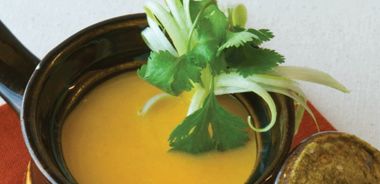Carrot Ginger Soup

This spicy carrot soup has a unique heat that comes from the combination of fresh ginger and Thai red curry paste. Choose your level of heat and either use 1 or 2 tsp of this amazing little condiment.
1 Tbsp (15 mL) extra-virgin olive oil
1 medium onion, coarsely chopped
4 cloves garlic, diced
3 cups (750 mL) low-sodium chicken stock
1 1/2 Tbsp (22 mL) fresh ginger root, minced
4 cups (1 kg) thinly sliced carrots
1 – 14 oz (398 mL) can light coconut milk
1 to 2 tsp (5 to10 mL) Thai red curry paste
1/2 tsp (2 mL) lemon zest
1 Tbsp (15 mL) fresh lemon juice
1/2 cup (125 mL) fresh cilantro, chopped
Heat medium pot over medium heat. Add oil and onion. Saute till onion is slightly golden brown, about 4 minutes. Add garlic and saute for 1 minute.
Pour in chicken stock. Add ginger and carrots. Bring to the boil, cover, reduce heat to low, and simmer for 30 minutes or until carrots are soft.
Remove soup from heat. Pur'ee soup using a hand-held immersion blender or transfer soup to a blender. Pur'ee till smooth.
Add coconut milk, curry paste, lemon zest, and lemon juice. Pulse or blend till smooth.
Serve sprinkled with chopped cilantro.
Makes 7 cups (1.75 L).
Each 1 cup (250 mL) serving contains: 81 calories; 2.3 g protein; 3.9 g total fat (2.1 g sat. fat, 0 g trans fat); 8 g carbohydrates; 1.5 g fibre; 292 mg sodium
source: "Winter Vegetables", alive #327, January 2010




